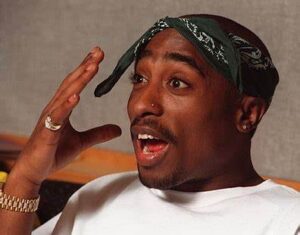 Tupac “2Pac” Shakur was, and remains, one of the most popular rappers of all time. He was born in New York City in 1971, but at 15 moved to Maryland with his family. There he was able to foster his artistic talents by attending the Baltimore School for the Arts, where he acted, wrote poetry, studied music, and often rapped for his classmates under the stage name MC New York. Two years later his family moved again to California; there he attended the poetry and performance classes of Leila Steinberg, who soon became his mentor and manager. Steinberg got Tupac his big break in 1989, when she introduced him to fellow manager Atron Gregory and successful hip hop group Digital Underground. Tupac toured and recorded with the group for several years until he released his first solo album in 1991.
Tupac “2Pac” Shakur was, and remains, one of the most popular rappers of all time. He was born in New York City in 1971, but at 15 moved to Maryland with his family. There he was able to foster his artistic talents by attending the Baltimore School for the Arts, where he acted, wrote poetry, studied music, and often rapped for his classmates under the stage name MC New York. Two years later his family moved again to California; there he attended the poetry and performance classes of Leila Steinberg, who soon became his mentor and manager. Steinberg got Tupac his big break in 1989, when she introduced him to fellow manager Atron Gregory and successful hip hop group Digital Underground. Tupac toured and recorded with the group for several years until he released his first solo album in 1991.
Although initially signing with Intersope Records, Shakur became increasingly involved with Marion “Suge” Knight’s Death Row Records, famous for its violent tactics and role in the “East Coast vs. West Coast” rap feud. Death Row boasted powerhouse California artists such as Tupac, Dr. Dre, and Snoop Dogg, while the East Coast-equivalent label, Sean “Puff Daddy/P. Diddy” Combs’s Bad Boy Records, was home to New York artists like Christopher “Notorious B.I.G.” Wallace. Although Tupac was initially close with Wallace because of his New York roots, the growing rivalry between the labels would soon turn the two against each other and lead to fatal consequences.
Shakur was facing trial in a sexual assault case when he went to Quad Studios in New York on November 30, 1994, to record a song with Christopher Wallace and Sean Combs. While Wallace and Combs were upstairs, Tupac and his associates walked into the lobby of the recording studio, where they were robbed at gunpoint by three men. Shakur attempted to defend himself and was shot five times. He survived, and even made it to court the next day, where he was sentenced to 1.5-4.5 years in prison.
While in jail, Shakur came to the conclusion that Wallace and Combs had orchestrated the attack, intentionally inviting him to their studio as a setup. Though Wallace furiously denied the claims, the incident fueled the rivalry and tensions steadily rose. Tupac was released from prison after serving nine months of his sentence, at which point he officially joined Suge Knight and signed onto Death Row Records. With Tupac again free to record, the feud between coasts grew even more hostile than before.
On September 7, 1996, Shakur, Knight, and several bodyguards attended a Mike Tyson fight at the MGM Grand in Las Vegas. A brawl erupted in the lobby of the hotel when they saw a man named Orlando Anderson, a member of the California gang the Crips, who had recently robbed one of Death Row’s entourage members (associated with rival gang the Bloods). In retaliation, Shakur led his group in attacking Anderson until the fight was stopped by hotel security.
Later that night, the Death Row group was headed to a club with Shakur in the passenger seat of a black BMW being driven by Knight. A white Cadillac pulled up beside them and fired several shots. Shakur was hit four times in the chest, while one bullet grazed Knight’s head. Shakur was raced to the hospital, where he remained alive for six days, undergoing several surgeries. Finally, on September 13, 1996, Shakur succumbed to his wounds.
Several theories have been put forth regarding the identity and motives of the murderer. The most accepted by law enforcement is that Anderson tracked down Shakur after Wallace agreed to pay $1 million for the hit. Unfortunately, because cooperation with police was minimal by members of both gangs, police were unable to positively identify Anderson as the shooter. Anderson was killed in an unrelated gang shooting two years later, still maintaining his innocence and never having been charged for Shakur’s death.
Others believe that Suge Knight was behind the hit, as Shakur was racking up legal fees and Knight may have believed Shakur to be worth more in posthumous album sales than alive. In 2017, Knight himself added yet another theory, saying in an interview he believed the shooting was actually intended to be a hit on him as part of a Death Row coup plotted by his ex-wife.
Sadly, without the help of witnesses, and Anderson no longer alive, Shakur’s murder remains unsolved.
Back to Crime Library
|
|
|
